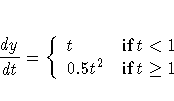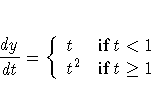ODE Call
performs numerical integration of vector
differential equations of the form
-
[(dy)/dt] = f(t,y(t)) with y(0) = c
- CALL ODE( r, "dername", c, t, h<,
J="jacobian"><,
EPS=eps><, "data">);
The ODE subroutine returns the following values:
- r
- is a numeric matrix that contains the results
of the integration over connected subintervals.
The number of columns in r is equal to the number of
subintervals of integration as defined by the argument t.
In case of any error in the integration on any
subinterval, partial results will not be reported in r.
The inputs to the ODE subroutine are as follows:
- "dername"
- specifies the name of an IML module
used to evaluate the integrand.
- c
- specifies an initial value vector for the variable y.
- t
- specifies a sorted vector that describes the
limits of integration over connected subintervals.
The simplest form of the vector t contains only
the limits of the integration on one interval.
The first component of t should contain the
initial value, and the second component should
be the final value of the independent variable.
For more advanced usage of the ODE subroutine, the
vector t can contain more than two components.
The components of the vector must be sorted in ascending order.
Two consecutive components of the vector
t are interpreted as a subinterval.
The ODE call reports the final result of integration
at the right endpoint of each subinterval.
This information is vital if f(·)
has internal points of discontinuity.
To produce accurate solutions, it is essential that
you provide the location of these points in the
variable t, since the continuity of the forcing
function is vital to the internal control of error.
- h
- specifies a numeric vector that contains three components:
the minimum allowable step size, hmin; the maximum
allowable step size, hmax; and the initial step size to
start the integration process, hinit.
- "jacobian"
- optionally specifies the name of an IML module
that is used to evaluate the Jacobian analytically.
The Jacobian is the matrix J, with

If the "jacobian" module is not specified, the ODE call
uses a finite difference method to approximate the Jacobian.
The keyword for this option is J.
- eps
- specifies a scalar indicating the required accuracy.
It has a default value of 1E-4.
The keyword for this option is EPS.
- data
- (scalar, optional, character, input)
a valid predefined SAS Dataset name that is used to
save the successful independent and dependent variables
of the integration at each step.
The ODE subroutine is an adaptive, variable
order, variable step-size, stiff integrator
based on implicit backward-difference methods.
Refer to Aiken (1985), Bickart and Picel (1973), Donelson
and Hansen (1971), Gaffney (1984), and Shampine (1978).
The integrator is an implicit predictor-corrector
method that locally attempts to maintain the
prescribed precision eps relative to

As you can see from the expression, this quantity is dynamically
updated during the integration process and can help you to
understand the validity of the results reported by the subroutine.
Consider the differential equation
-
[dy/dt] = -ty with y = 0.5 at t = 0
The following statements attempt to find the solution at t=1:
proc iml; ;
/* Define the integrand */
start fun(t,y);
v = -t*y;
return(v);
finish;
/* Call ODE */
c = .5;
t = { 0 1};
h = { 1E-12 1 1E-5};
call ode(r,"FUN",c,t,h);
print r[format=E21.14];
In this case, the integration is carried out
over (0, 1) to give the value of y at t=1.
The optional parameter eps has not been
specified, so it is internally set to 1E-4.
Also, the optional parameter "jacobian"
has not been specified, so finite difference
methods are used to estimate the Jacobian.
The accuracy of the answer can be
increased by specifying eps.
For example, set eps=1E-7 as follows:
proc iml;
/* Define the integrand */
start fun(t,y);
v = -t*y;
return(v);
finish;
/* Call ODE */
c = .5;
t = {0 1};
h = {1E-12 1. 1E-5};
call ode(r,"FUN",c,t,h) eps=1E-7;
print r[format =E21.14];
Compare this value to 0.5e-0.5 = 3.03265329856310E-01
and observe that the result is correct through the sixth decimal
digit and has an error relative to 1 that is O(1E-7).
If the solution was desired at 1 and 2 with an accuracy
of 1E-7, you would use the following statements:
proc iml;
/* Define the integrand */
start fun(t,y);
v = -t*y;
return(v);
finish;
/* Call ODE */
c = .5;
t = { 0 1 2};
h = { 1E-12 1. 1E-5};
call ode(r,"FUN",c,t,h) eps=1E-7;
print r[format=E21.14];
Note that R contains the solution at t=1 in the
first column and at t=2 in the second column.
Now consider the smoothness of the forcing function f(·).
For the purpose of estimating errors, adaptive methods
require some degree of smoothness in the function f(·).
If this smoothness is not present in f(·) over the
interior and including the left endpoint of the subinterval,
the reported result will not have the desired accuracy.
The function f(·) must be at least continuous.
If the function does not meet this requirement, you
should specify the discontinuity as an intermediate point.
For example, consider the differential equation

To find the solution at t=2, use the following statements:
proc iml;
/* Define the integrand */
start fun(t,y);
if t < 1 then v = t;
else v = .5*t*t;
return(v);
finish;
/* Call ODE */
c = 0;
t = { 0 2};
h = { 1E-12 1. 1E-5};
call ode(r,"FUN",c,t,h) eps = 1E-12;
print r[format =E21.14];
In the preceding case, the integration is
carried out over a single interval, (0,2).
The optional parameter eps is specified to be 1E-12.
The optional parameter jacobian is not specified, so
finite difference methods are used to estimate the Jacobian.
Note that the value of R does not have the required
accuracy (it should contain a 12 decimal-place representation
of 5/3), although no error message is produced.
The reason is that the function is
not continuous at the point t=1.
Even the lowest-order method cannot produce a local
reliable error estimate near the point of discontinuity.
To avoid this problem, you can create
subintervals so that the integration is carried
out first over (0,1) and then over (1,2).
The following code implements this method:
proc iml;
/* Define the integrand */
start fun(t,y);
if t < 1 then v = t;
else v = .5*t*t;
return(v);
finish;
/* Call ODE */
c = 0;
t = { 0 1 2};
h = { 1E-12 1. 1E-5};
call ode(r,"FUN",c,t,h) eps=1E-12;
print r[format=E21.14];
The variable R contains the solutions at both t=1
and t=2, and the errors are of the specified order.
Although there is no interest in the solution at the
point t=1, the advantage of specifying subintervals
with no discontinuities is that the function f(·)
is infinitely differentiable in each subinterval.
When f(·) is continuous, the ODE subroutine
can compute the integration to the specified
precision, even if the function is defined piecewise.
Consider the differential equation

The following code finds the solution at t=2:
Since the function f(·) is continuous, the
requirements for error control are satisfied.
proc iml;
/* Define the integrand */
start fun(t,y);
if t < 1 then v = t;
else v = t*t;
return(v);
finish;
/* Call ODE */
c = .5;
t = { 0 2};
h = { 1E-12 1. 1E-5};
call ode(r,"FUN",c,t,h) eps=1E-12;
print r[format=E21.14];
This example compares the ODE call to an
eigenvalue decomposition for stiff-linear systems.
In the problem
-
[(dy)/dt] = Ay with y(0) = c
where A is a symmetric constant matrix, the solution can be
written in terms of the eigenvalue decomposition, as follows:
-
y(t) = UeDt U' c
where U is the matrix of eigenvectors and D is
a diagonal matrix with the eigenvalues on its diagonal.
The following statements produce two solutions, one using the
ODE call and the other using the eigenvalue decomposition:
proc iml;
/* Define the integrand */
start fun(t,x) global(a,count);
count = count+1;
v = a*x;
return(v);
finish;
/* Define the Jacobian */
start jac(t,x) global(a);
v = a;
return(v);
finish;
a = {-1000 -1 -2 -3,
-1 -2 3 -1,
-2 3 -4 -3,
-3 -1 -3 -5 };
/* Call ODE */
count = 0;
t = { 0 1 2};
h = {1E-12 1 1E-5};
eps = 1E-9;
c = {1, 0, 0, 0 };
call ode(z,"FUN",c,t,h) eps=eps j="JAC";
print z[format=E21.14];
print count;
/* Do the eigenvalue decomposition */
start eval(t) global(d,u,c);
v = u*diag(exp(d*t))*u`*c;
return(v);
finish;
call eigen(d,u,a);
free z1;
do i = 1 to nrow(t)*ncol(t)-1;
z1 = z1 || (eval(t[i+1]));
end;
print z1[format=E21.14];
The question now is whether this is an O(1E-9) result.
Note that for this problem

with the 1E-6 result, the ODE call should attempt
to maintain an accuracy of 1E-9 relative to 1.
Therefore, the 1E-6 result should have
almost three correct decimal places.
At t=2, the first component of Z is
6.58597048842310E-06, while its more accurate value is
6.58580950203220E-06, showing an O(1E-10) error.
The ODE subroutine may fail for problems with
unusual qualitative properties, such as finite escape
time in the interval of integration (that is, the
solution goes towards infinity at some finite time).
In such cases, try testing with different subintervals and
different levels of accuracy to gain some qualitative information
about the behavior of the solution of the differential equation.
Copyright © 1999 by SAS Institute Inc., Cary, NC, USA. All rights reserved.




